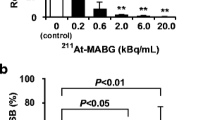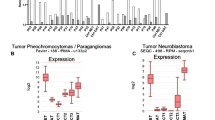Abstract
meta-Iodobenzylguanidine (MIBG) is a multipotent drug used in its radiolabeled form as a tumor-seeking radiopharmaceutical in the diagnosis and treatment of pheochromocytoma and neuroblastoma. Nonradiolabeled MIBG has also proved to be effective in the palliation of carcinoid syndromes and, on a predosing schedule, in enhancing the relative tumor uptake of a subsequent [131I]-MIBG dose in tumors of neuroadrenergic origin. In addition, MIBG is under investigation as an inhibitor of mitochondrial respiration and, as such, for its use in tumor-specific acidification. In this report we describe the side effects of nonradiolabeled MIBG on kidney function in mice. High doses of MIBG (40 mg/kg) reduced renal blood perfusion as measured by 86Rb distribution by 50%, which could be antagonized by the bioamine receptor blockers prazosin and cyproheptadine. MIBG also induced reversible renal damage as evidenced from a decrease in [51Cr]-ethylenediaminetetraacetic acid (EDTA) clearance and from histological damage, which was most pronounced in the distal tubuli. These effects were unrelated to reduced perfusion, however, and could not be antagonized by bioamine receptor blockers, Ca2+-channel blockers, or diuretics. Clearance effects of MIBG were mimicked by N-nitro-l-arginine methyl ester (l-NAME), a known inhibitor of nitric oxide synthase (NOS), and MIBG itself (100 μM) also inhibited NOS in vitro, suggesting that NOS inhibition by MIBG may have contributed to the observed reduction in renal clearance. The MIBG analog benzylguanidine (BG), which is equipotent in terms of mitochondrial inhibition, did not affect renal clearance, thus excluding mitochondrial inhibition as the main mechanism of MIBG-induced damage. MIBG, however, was much more cytotoxic than BG to kidney tubular cells in primary cultures. Although the renal effects of high-dose MIBG were reversible, alterations in the pharmacokinetics of concomitant medications by a temporary reduction in renal function should be taken into account in its clinical application.
Similar content being viewed by others
Author information
Authors and Affiliations
Additional information
Received: 29 July 1997 / Accepted: 14 November 1997
Rights and permissions
About this article
Cite this article
Kuin, A., Aalders, M., van der Valk, M. et al. Renal toxicity of the neuron-blocking and mitochondriotropic agent m-iodobenzylguanidine. Cancer Chemother Pharmacol 42, 37–45 (1998). https://doi.org/10.1007/s002800050782
Issue Date:
DOI: https://doi.org/10.1007/s002800050782




